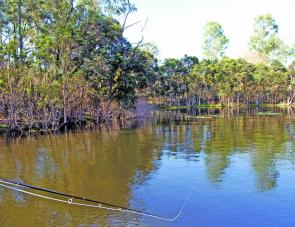The prospect of taking a barra on fly is one that many fly anglers aspire to, but it’s my guess that few would realize how easy it is. Hooking a barra can be easy, however landing it can be a completely different story!
Firstly, let’s give some thought to where fly and barra might come together. North of Maryborough is the start of coastal habitat, although impoundment barra certainly take flies just as readily as their saltwater counterparts.
There’s no doubting that some of the post flood dams have reduced fish numbers these days, but if we look at Monduran Dam for instance, barra are now being taken on lures as regular as they were pre-flood. If they are taking lures there’s no reason why the fly gear shouldn’t score a fish or two.
When it comes to barra, upsizing gear is the way to go. A 10# rod should have sufficient power to hold a fish; barra like to take their fight straight into the timber and a lesser weight rod can fall short in the power stakes. Matched to the rod will be a 10# intermediate sink rate line - the Rio Saltwater 10/11 Tropical Clear Tip with a formed loop each end makes connection to backing and leader easy and is ideal for all main daylight sunken fly work, with a possible change over to a floating line of the same weight at daylight or dusk with the surface fly in action.
I make up leaders from sections of around one and a half metres of 20kg line, a metre of 15kg line, half a metre of 12kg, then at least another half metre of 20kg again to guard against gill raker cut offs. The 500mm of 12kg is a break point to avoid losing a fly line if a real big bloke hooks up and gallops into the sticks. He’s never coming back any way so why lose a fly line in the process? Better to have a leader section that will break under really hard pressure than to suffer that sort of loss.
The ideal barra reel will be one that can be used on the likes of tuna or mackerel. It’s large, very robust, with an easily adjusted and very strong drag that can be wound up to near full lock for reasons we will see later. The selected reel should also be able to take a hiding from saltwater use.
Flies need to be big, bold, bulky and bright. Deceiver style flies work fine as do large Bendbacks. You can vary colour as much you like - leave it to the fish to decide what they want on the day. My view is that a fly tied on a 4/0 or 5/0 hook is a hard thing to resist when it lands in front of a snag or feature then moves off flashing and sparkling in little twitches and jerks imparted by the angler. The hit comes as an almighty wrench without the slightest inkling of what’s going to happen. One second the fly is coming back, the next the rod is almost torn from the hand. That’s barra fishing!
The trick is to pick the right situation to fish in if you want to land fish rather than just hook them. Barra love cover, yet in the freshwater they can often be found in proximity to cover without actually being so close that it makes landing a hooked fish nigh impossible. I often anchor the boat right on the bank around 20m from a stand of timber - maybe on a point or other feature - and make casts straight out from the bank with a stop start retrieve in continual use. It’s very much a waiting game but it works; sooner or later a fish will come past and grab the fly.
The clue is to actively cast to selected features in fairly open water. Still keeping close to the bank in the shallower water where fish look for tucker, the boat can be driven gently under electric power while casts are made to features such as lily beds or partly submerged bushes. This latter tactic works in the salt water as well.
The angler needs to estimate the chance of keeping control of a fish for those first vital seconds and keeping them away from the sang. To do this look for a snag standing away from others or alternatively drift quietly with casts made to selected bank side features.
I recently did a fair amount of saltwater work on these fish and found that time of day was very important if you were looking for an increased hook up rate. First light and dusk were red hot times as expected. I also noted that tidal movement was important. The old story - no run, no fun. In the saltwater situation the fish were fairly predictable. If a hit or boil from a follow didn’t come after three or four casts at a feature the idea was to move to another one.
Both fresh or saltwater fishing involves the angler trying hard to keep control for those first couple of seconds and a near locked drag may be the only way to stay ahead of the play.
Fresh or salt water, barra on fly are a worthwhile challenge for an angler that wants to take their game to the next level.
Reads: 7045
With impoundment levels high, lily beds offer ideal barra habitat and are worth exploring with the fly.

Scott Kampe with a neat saltwater barra.

Upsizing is the way to go with barra. These rough looking flies are all tied on 4/0 hooks.




